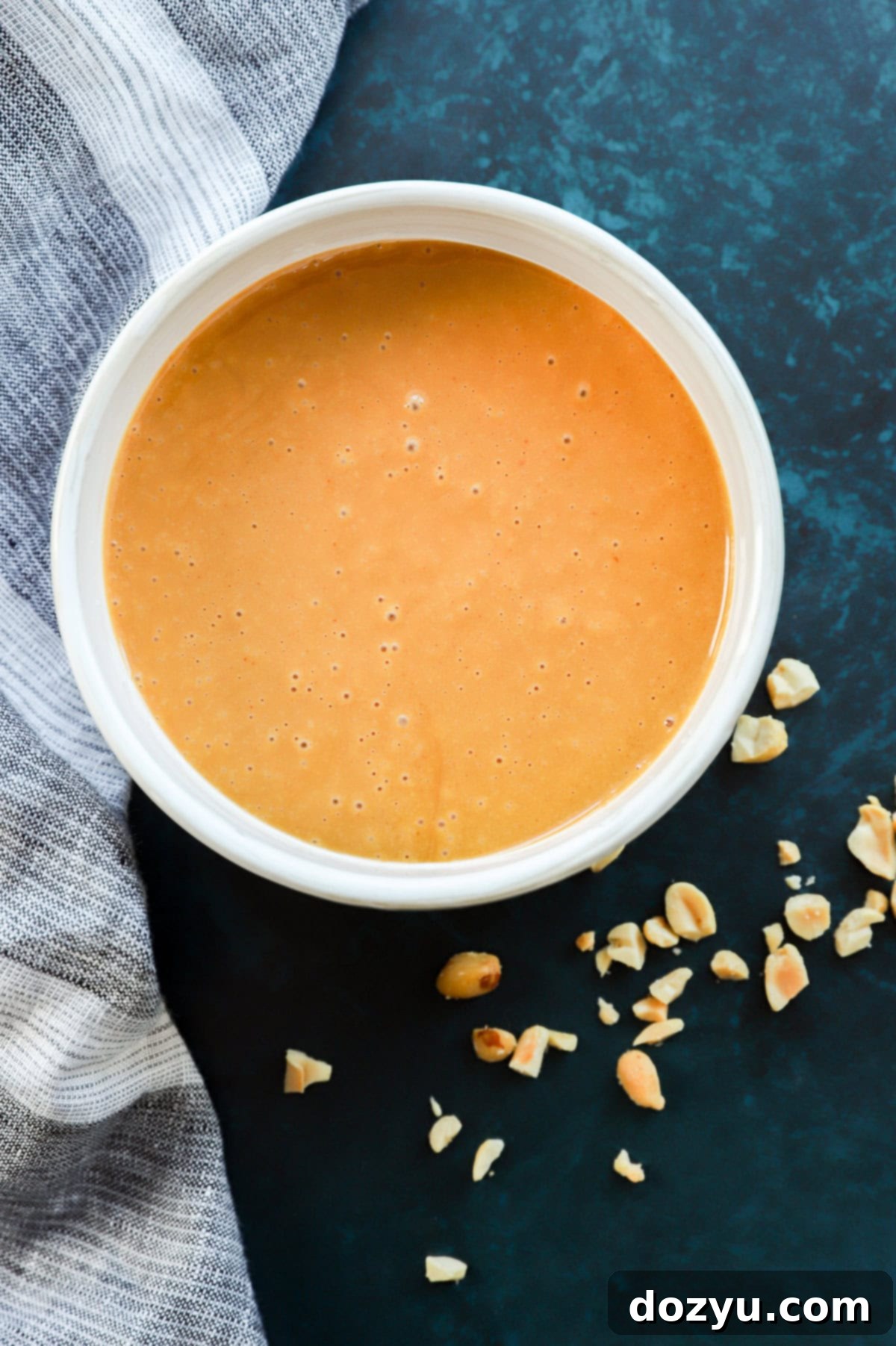Easy Homemade Thai Peanut Dressing Recipe: The Ultimate Versatile Sauce for Salads, Bowls & More
This simple and undeniably delicious homemade Thai peanut dressing is a culinary chameleon, perfect for elevating everything from crisp salads and grilled chicken to vibrant Buddha bowls, spring rolls, and more. Crafted with just a handful of accessible ingredients, it’s remarkably easy to whip up, transforming any meal with its irresistible burst of savory, sweet, and tangy flavors. Get ready to make this creamy, dreamy sauce a staple in your kitchen!
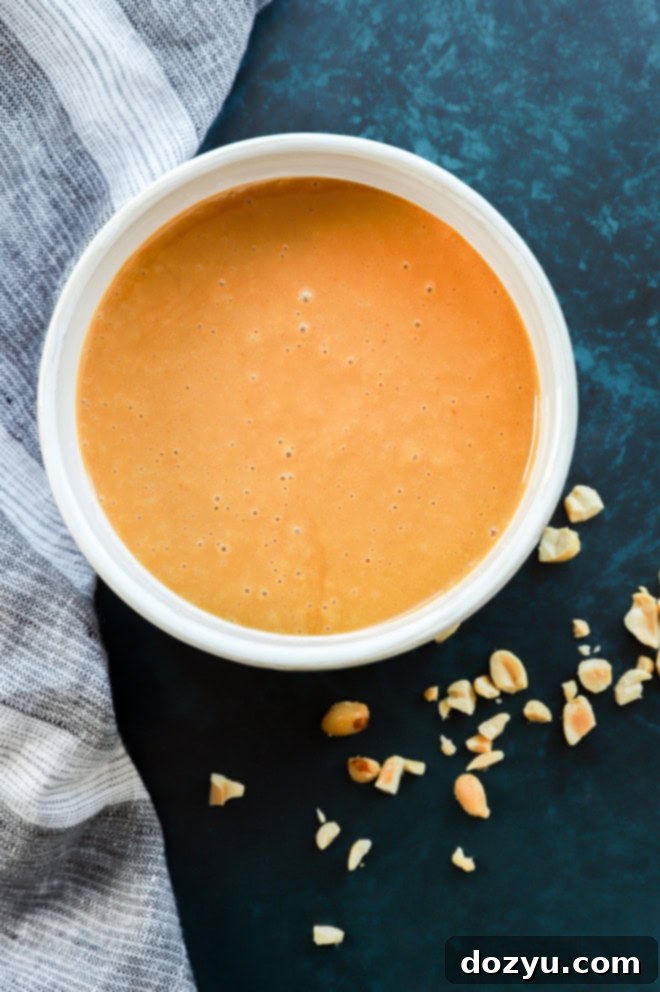
table of contents
Toggle
About This Thai Peanut Dressing
Let’s be honest, the secret to truly enjoying a salad – or pretty much any dish that needs a flavor boost – lies squarely in the dressing. It needs to be exceptional, the kind that makes you eagerly anticipate every bite, transforming even the simplest ingredients into a culinary delight. It should be so good that you’d want to drizzle it on everything, from crunchy greens to savory meats, and even secretly lick it off the spoon!
This Thai peanut dressing perfectly embodies that irresistible quality. It strikes an exquisite balance between creamy richness, vibrant tanginess, and a subtle, delightful kick of spice. Each spoonful delivers a complex flavor profile that tantalizes your taste buds and leaves you craving more. It’s a game-changer, designed to make you genuinely excited about eating your vegetables.
I originally developed this recipe out of a desire to break free from the monotonous cycle of standard vinaigrettes. Now, it’s a permanent fixture in my refrigerator, always ready to elevate our meals. While its primary role might be a stellar salad dressing, its versatility knows no bounds. Think beyond the salad bowl and get creative!
Imagine it as a sophisticated dipping sauce for fresh spring rolls, a delectable marinade for grilled chicken or tofu, or even as a luscious sauce tossed with your favorite noodles. It’s so much more than just a dressing; it’s a flavor powerhouse that can revolutionize your weeknight dinners and light lunches. While I can’t promise it will solve all your daily challenges, it will certainly make your meals more exciting and undeniably delicious. And sometimes, that’s exactly what you need!
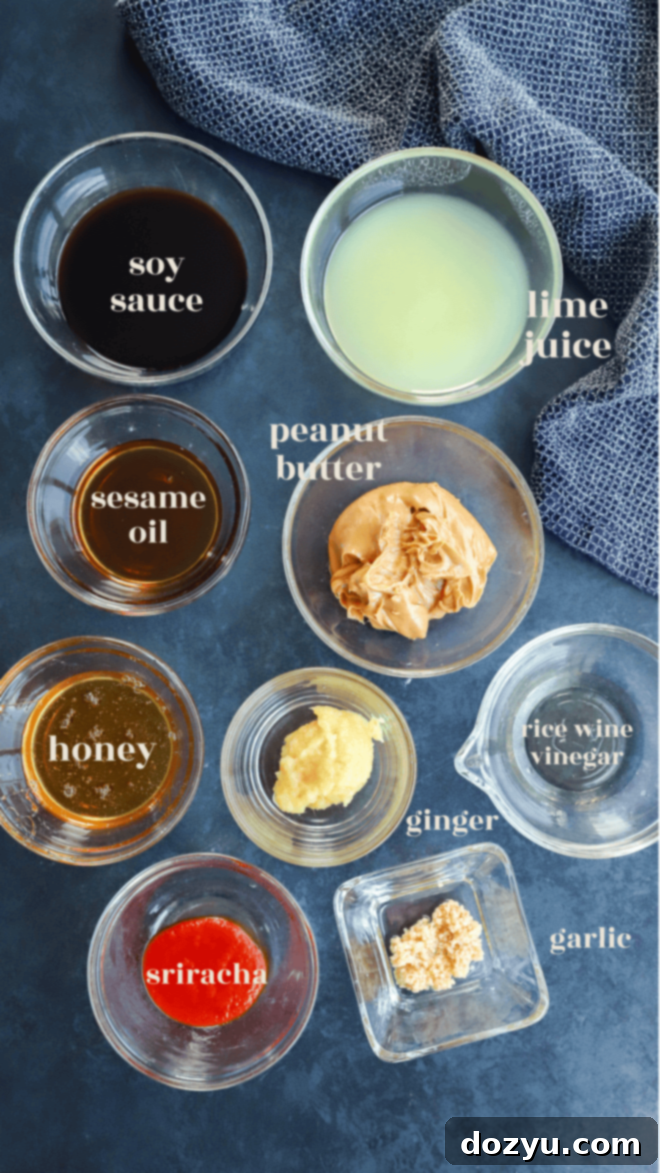
Key Ingredients for the Perfect Peanut Dressing
Creating this irresistible Thai peanut dressing requires a thoughtful blend of high-quality ingredients, each playing a crucial role in achieving its complex and balanced flavor profile. Here’s a closer look at what you’ll need and why each component is essential:
- Ginger: Fresh ginger is truly the star here, imparting a vibrant, zesty flavor with a delightful spicy bite. You can opt for a good quality store-bought ginger paste for convenience, or for the freshest taste, simply peel and grate a knob of fresh ginger yourself. The pungent aroma and fiery notes of fresh ginger are irreplaceable.
- Garlic: Essential for depth, garlic adds a robust savory foundation to the dressing. While pre-minced garlic offers ease, using whole fresh garlic cloves that you mince yourself will always deliver a more intense and aromatic flavor. Don’t skip this critical ingredient!
- Peanut Butter: The creamy backbone of our dressing! Smooth, creamy peanut butter is highly recommended for achieving that luxurious, velvety texture. Choose your favorite brand, but be aware that natural peanut butter (the kind that separates) might require a bit more blending and potentially a touch more liquid to reach the desired consistency. The rich, nutty flavor of peanut butter is central to this Thai-inspired sauce.
- Lime: Fresh lime juice is absolutely non-negotiable for the brightest, most authentic flavor in this recipe. Its tangy, acidic notes cut through the richness of the peanut butter, balancing the sweetness and adding a vital layer of freshness. Bottled lime juice simply won’t yield the same vibrant result.
- Soy Sauce: This provides the crucial umami and salty elements. We typically opt for low-sodium soy sauce to better control the overall saltiness, allowing us to season to taste at the end. However, regular soy sauce works too if that’s what you have. For a gluten-free version, readily substitute with tamari or coconut aminos.
- Honey: Our preferred natural sweetener, honey brings a delicate sweetness and a subtle floral note that complements the other flavors beautifully. If you’re looking for a vegan alternative, or simply prefer a different sweetener, maple syrup or agave nectar are excellent substitutes.
- Toasted Sesame Oil: This ingredient is a game-changer! Toasted sesame oil is incredibly potent and adds an unparalleled layer of nutty, roasted depth to the dressing. A small amount goes a long way in enhancing the overall Asian-inspired flavor profile. Be sure to use toasted sesame oil, not plain sesame oil, for the distinctive flavor.
- Vinegar: Red wine vinegar contributes a wonderful sharp, slightly fruity acidity that perfectly balances the rich and savory components. If you don’t have red wine vinegar on hand, rice vinegar is an excellent alternative, offering a milder, slightly sweeter acidity that is also very common in Asian cuisine.
- Sriracha: For those who love a bit of heat, Sriracha is your go-to! It adds a fantastic spicy kick and a touch of chili flavor. You can adjust the amount to your personal preference – add more for a fiery dressing, or less for a mild hint of warmth. Feel free to use your favorite hot sauce if Sriracha isn’t available.
- Salt and Pepper: A foundational seasoning duo. Kosher salt and freshly cracked black pepper are essential for enhancing all the other flavors. Always remember to taste your dressing before and after seasoning to achieve the perfect balance.
Essential Tools for Making This Dressing
While this Thai peanut dressing is incredibly simple to prepare, having the right tools can make the process even smoother and more efficient:
- Measuring Cups and Spoons: Accuracy is key in recipes, especially with dressings where the balance of flavors is so important. Make sure you have a reliable set of measuring cups and measuring spoons to ensure you get the ratios just right.
- High-Speed Blender or Food Processor: This is where the magic happens! A powerful appliance like a Vitamix or any standard food processor will effortlessly blend all the ingredients into a perfectly smooth and creamy dressing in just a minute or two. This ensures no lumps and a consistent texture.
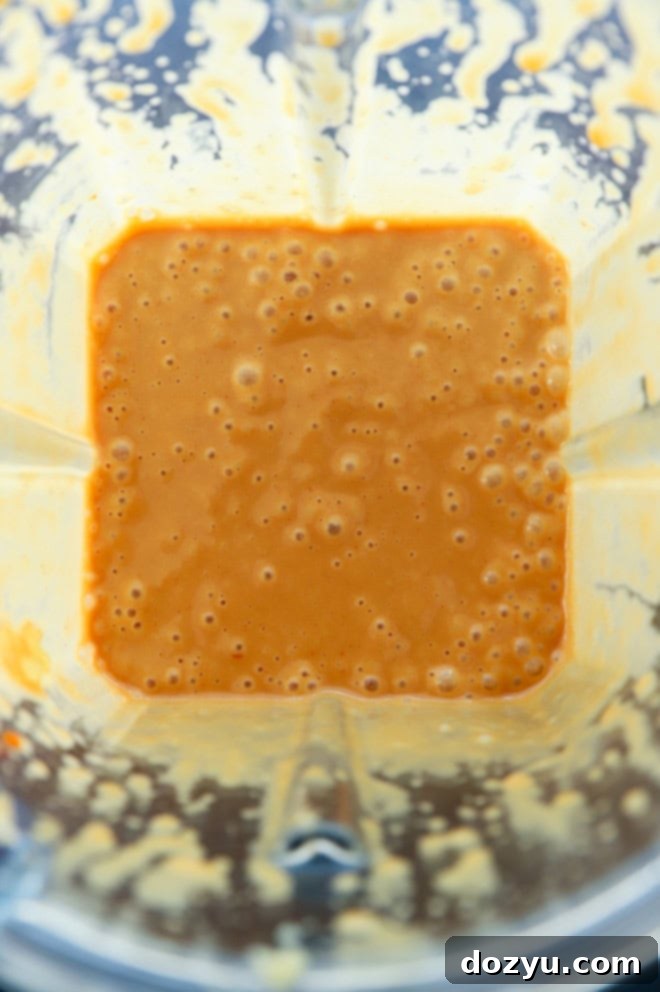
How to Make Easy Thai Peanut Dressing
Making this incredible Thai peanut dressing couldn’t be simpler. It’s truly a “dump and blend” recipe that comes together in minutes, making it perfect for busy weeknights or meal prep. Follow these straightforward steps to create your own batch of this versatile sauce:
Blend for Creamy Perfection
Begin by gathering all your ingredients. Carefully measure out the ginger (whether paste or freshly grated), minced garlic, creamy peanut butter, fresh lime juice, soy sauce (or gluten-free alternative), honey (or your chosen sweetener), toasted sesame oil, rice wine vinegar (or red wine vinegar), and Sriracha. Add all of these flavorful components directly into the pitcher of your high-speed blender or the bowl of your food processor.
Once all ingredients are in, secure the lid and blend on high until the mixture is completely smooth and wonderfully creamy. You might need to pause occasionally to scrape down the sides of the blender or food processor with a spatula to ensure all ingredients are thoroughly incorporated and no lumps remain. Continue blending until you achieve a consistently silky texture.
Taste and Adjust
This is a crucial step to personalize your dressing! Once the dressing is smooth, taste a small spoonful. Evaluate the flavor balance: is it tangy enough? Does it need more sweetness? Is the saltiness just right, or could it use a pinch more? Does it have the perfect amount of heat, or would you prefer it spicier? Adjust with additional salt, freshly cracked black pepper, or more Sriracha as desired until it perfectly suits your palate. A little extra lime juice can brighten it, or a touch more honey can mellow the spice.
Store After Blending
Once you’re satisfied with the flavor, your homemade Thai peanut dressing is ready to enjoy immediately! If you’re not using it all right away, transfer it to a clean, airtight container. A mason jar works beautifully for this purpose, keeping it fresh. Store it in the refrigerator, where it will maintain its vibrant flavor and creamy texture for up to 4 days.
Customizing Your Dressing: Flavor Variations
This Thai peanut dressing recipe is incredibly flexible, allowing you to easily adjust it to your specific tastes and dietary preferences. Don’t be afraid to experiment and make it truly your own!
Make It Spicier
If you love a fiery kick, there are several ways to amplify the heat. The easiest method is to simply add more Sriracha, stirring it in a teaspoon at a time until you reach your desired level of spice. For a different kind of heat, you can also stir in a pinch of red pepper flakes. For even more fresh, aromatic heat, finely mince a fresh Thai bird’s eye chili (remove seeds for less extreme spice) and blend it into the dressing.
Make It Thicker or Thinner
The consistency of your dressing can greatly impact how it’s used. If you prefer a thicker dressing, perhaps for a dip or a more substantial coating on noodles, simply blend in an additional 2 to 3 tablespoons of peanut butter until the desired consistency is achieved. If you find your dressing is too thick, or you prefer a runnier consistency for drizzling over salads, gradually add a tablespoon of water, lime juice, or even a splash of coconut milk (for added creaminess and flavor) until it reaches your ideal texture.
Add Fresh Herbs
For an extra layer of freshness and aromatic complexity, consider blending in some fresh herbs. A handful of fresh cilantro or a few sprigs of mint can add a bright, herbaceous note that complements the rich peanut flavor beautifully. Add them in during the final blending stage to prevent over-processing.
More tasty sauces to try out: Garlic Aioli | Chipotle Aioli | Bang Bang Sauce | Roasted Garlic Aioli | Caesar Dressing
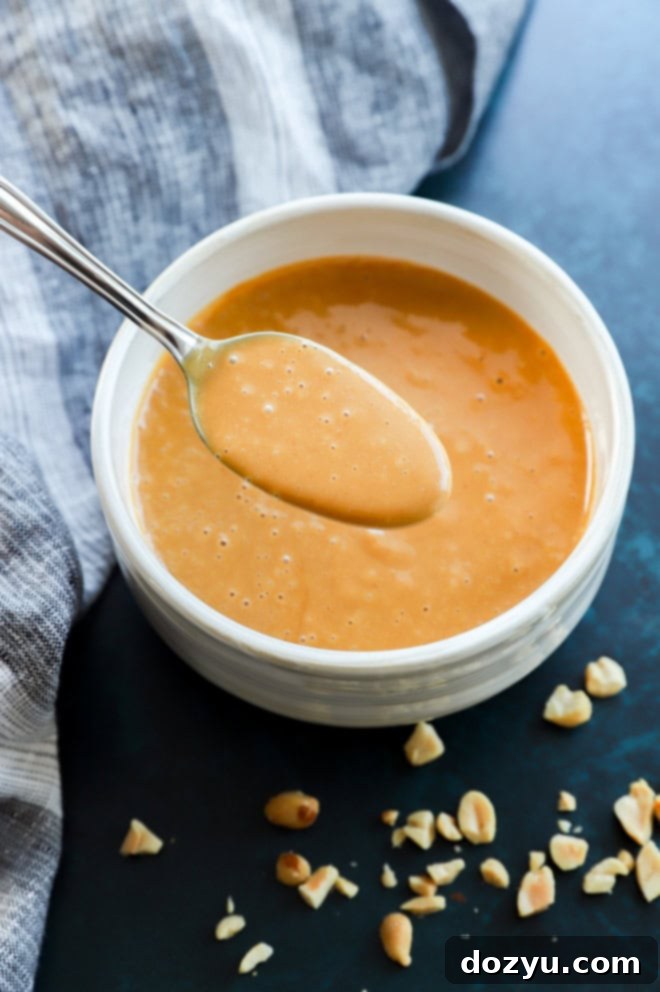
Frequently Asked Questions (FAQ)
Here are answers to some common questions you might have about making and enjoying this Thai Peanut Dressing:
Can I use a different nut butter other than peanut butter?
Absolutely! While peanut butter gives this dressing its classic “Thai peanut” identity, you can easily experiment with other nut butters to create a different, yet equally delicious, nutty sauce. Almond butter or cashew butter are excellent alternatives. Keep in mind that using a different nut butter will, of course, alter the overall flavor profile of the dressing. Almond butter tends to be a bit milder, while cashew butter can be creamier and slightly sweeter. Adjust other seasonings like honey, lime, and salt to taste when making substitutions.
Is there a way to make this dressing vegan?
Yes, making this dressing vegan is very simple! The only non-vegan ingredient in the original recipe is honey. To make it entirely plant-based, simply swap out the honey for an equal amount of maple syrup or agave nectar. Both provide a lovely sweetness that blends well with the other ingredients. Always taste and adjust seasonings after making this swap, as the flavor of different sweeteners can mildly impact the overall taste.
How long will this dressing last?
When stored properly, this homemade Thai peanut dressing will stay fresh and delicious in the refrigerator for up to 4 days. To ensure maximum freshness and flavor, always keep it in an airtight container or a tightly sealed mason jar. The flavors tend to meld and deepen slightly over time, so it often tastes even better the next day!
How to make this dressing gluten-free?
To make this dressing completely gluten-free, simply ensure that you use a gluten-free alternative for soy sauce. Tamari is a fantastic and readily available gluten-free soy sauce alternative that tastes very similar. Coconut aminos is another popular choice that also works well and offers a slightly sweeter, less salty profile, which might require minor adjustments to other ingredients to balance the flavors.
What if my dressing is too thick or too thin?
Adjusting the consistency is easy! If your dressing is too thick for your preference, gradually add a tablespoon of water, lime juice, or even a splash of unsweetened coconut milk (for extra creaminess) while blending, until it reaches your desired pourable consistency. If it turns out too thin, you can thicken it by adding another tablespoon or two of peanut butter and blending again until smooth.
Need more inspiration for a sweet treat? Check out my dessert recipes page!
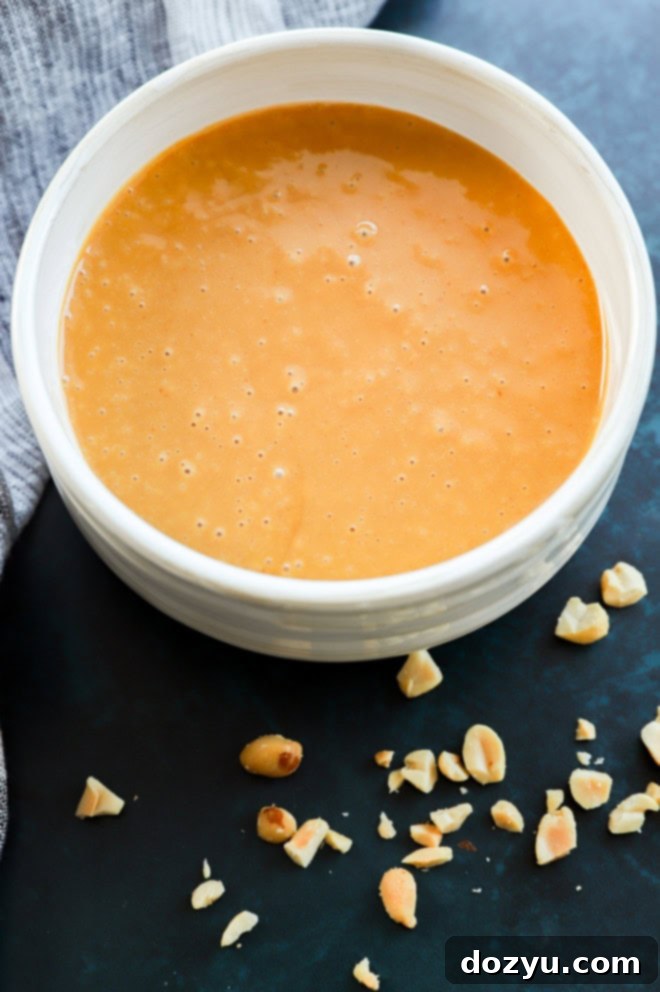
Endless Possibilities: How to Use Thai Peanut Dressing
This vibrant and flavorful Thai peanut dressing is incredibly versatile, extending far beyond the traditional salad bowl. Its rich, tangy, and subtly spicy notes make it a perfect companion for a wide array of dishes. Here are some inspiring ideas to incorporate this delicious dressing into your meals:
- Classic Salad Dressing: The most obvious, yet incredibly satisfying use! Drizzle generously over your favorite mixed green salads, especially those with crunchy vegetables like bell peppers, carrots, and cucumbers. It’s particularly fantastic with Asian-inspired salads featuring cabbage, edamame, and mandarin oranges.
- Dipping Sauce Extraordinaire: Elevate your appetizers and snacks! This dressing makes an exceptional dipping sauce for fresh Vietnamese spring rolls, crispy egg rolls, steamed or fried wontons, potstickers, and even simple veggie sticks.
- Marinade Marvel: Use it as a flavorful marinade for proteins. Chicken, pork, beef, shrimp, or even firm tofu chunks will absorb its delicious flavors, becoming tender and aromatic when grilled, baked, or stir-fried.
- Noodle Sauce Superstar: Toss it with warm or cold noodles for a quick and easy main course or side dish. It’s superb with rice noodles, spaghetti, or soba noodles, creating a Thai-inspired pasta salad or a satisfying noodle bowl. Add some shredded chicken or vegetables for a complete meal.
- Drizzle on Grains & Bowls: Transform a simple rice bowl, quinoa bowl, or Buddha bowl into a gourmet experience. Drizzle over cooked grains, roasted vegetables, and your protein of choice for a harmonious and flavorful dish.
- Sandwich & Wrap Enhancer: Spread a thin layer inside sandwiches, wraps, or pitas for a burst of Thai-inspired flavor. It pairs wonderfully with chicken, turkey, or even vegetarian fillings.
- Stir-Fry Sauce Shortcut: In a pinch, this dressing can serve as a quick stir-fry sauce. Sauté your favorite vegetables and protein, then toss with a few spoonfuls of the dressing at the very end of cooking to coat everything in its deliciousness.
- Vegetable Topper: Roast or steam your favorite vegetables (broccoli, cauliflower, asparagus, sweet potatoes) and then drizzle them with this dressing for an instant flavor upgrade.
Proper Storage for Maximum Freshness
To ensure your homemade Thai peanut dressing remains as delicious as the day you made it, proper storage is key. Following these simple guidelines will help maintain its flavor and consistency:
Store: Always transfer the dressing into an airtight container. A glass mason jar with a tight-fitting lid is an excellent choice as it prevents air exposure and can also be easily shaken to re-emulsify the dressing if any separation occurs. Store the sealed container in the refrigerator. It will keep well for up to 4 days. Before each use, give the container a good shake or stir to ensure all the flavors are evenly distributed, especially if it has thickened or separated slightly while chilling.
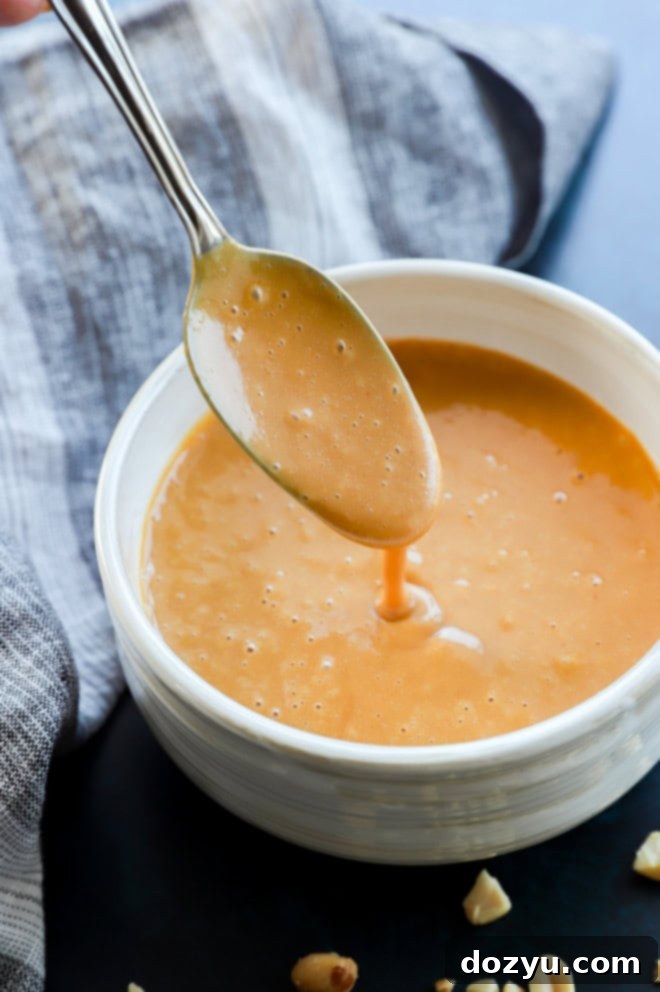
More Thai-Inspired Recipes to Try
If you’re a fan of the vibrant and aromatic flavors of Thai cuisine, then this peanut dressing is just the beginning! Here are a few more Thai-inspired recipes that you’re sure to love, many of which would pair beautifully with this versatile dressing:
-
Thai Shrimp Noodle Soup: This delightful soup offers a captivating blend of flavors. It features a rich, red curry and tomato-based broth that’s both comforting and invigorating. It’s light enough for a warm day, yet hearty and satisfying for cooler evenings, packed with tender shrimp and slurpable noodles. Imagine drizzling a little extra peanut dressing on top for an added layer of richness!
-
Thai Turkey Avocado Egg Rolls: These egg rolls are my absolute favorite Thai-inspired appetizer. They boast a wonderfully crispy exterior that gives way to a flavorful, savory filling of seasoned turkey and creamy avocado. They’re a fantastic snack or starter, and they pair exceptionally well with this homemade peanut dressing as a dipping sauce – a match made in culinary heaven!
-
Crunchy Thai Pasta Salad: Bring that irresistible peanut flavor to your side dishes with this vibrant and satisfying pasta salad. It’s loaded with fresh, crunchy vegetables, tender pasta, and coated in a delicious, savory dressing that echoes the flavors of our peanut sauce. It’s perfect for potlucks, meal prep, or as a light and refreshing main course.
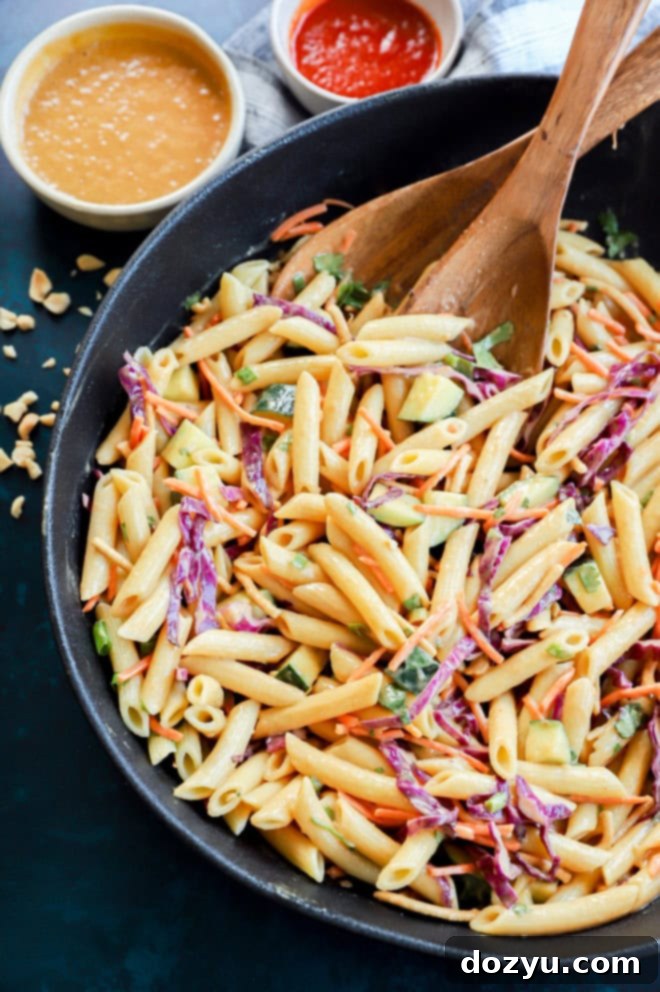
Finally, if you’ve had the pleasure of making this homemade Thai peanut salad dressing recipe, please consider leaving a star rating on the recipe card below and/or sharing your thoughts in a comment! Your feedback is incredibly valuable, and I genuinely love hearing about your experiences with my recipes. I always make an effort to respond to every single comment and question.
If you have any questions while making the dressing, feel free to drop them below!
Oh, and don’t forget to tag me on Instagram, Facebook, or Pinterest if you share photos of your culinary creations! Seeing these recipes come to life in your homes is truly my favorite part of what I do – it means the world to me!
Want to be the first to know when a new recipe drops or catch up on the latest culinary news? Be sure to sign up for my exclusive newsletter!
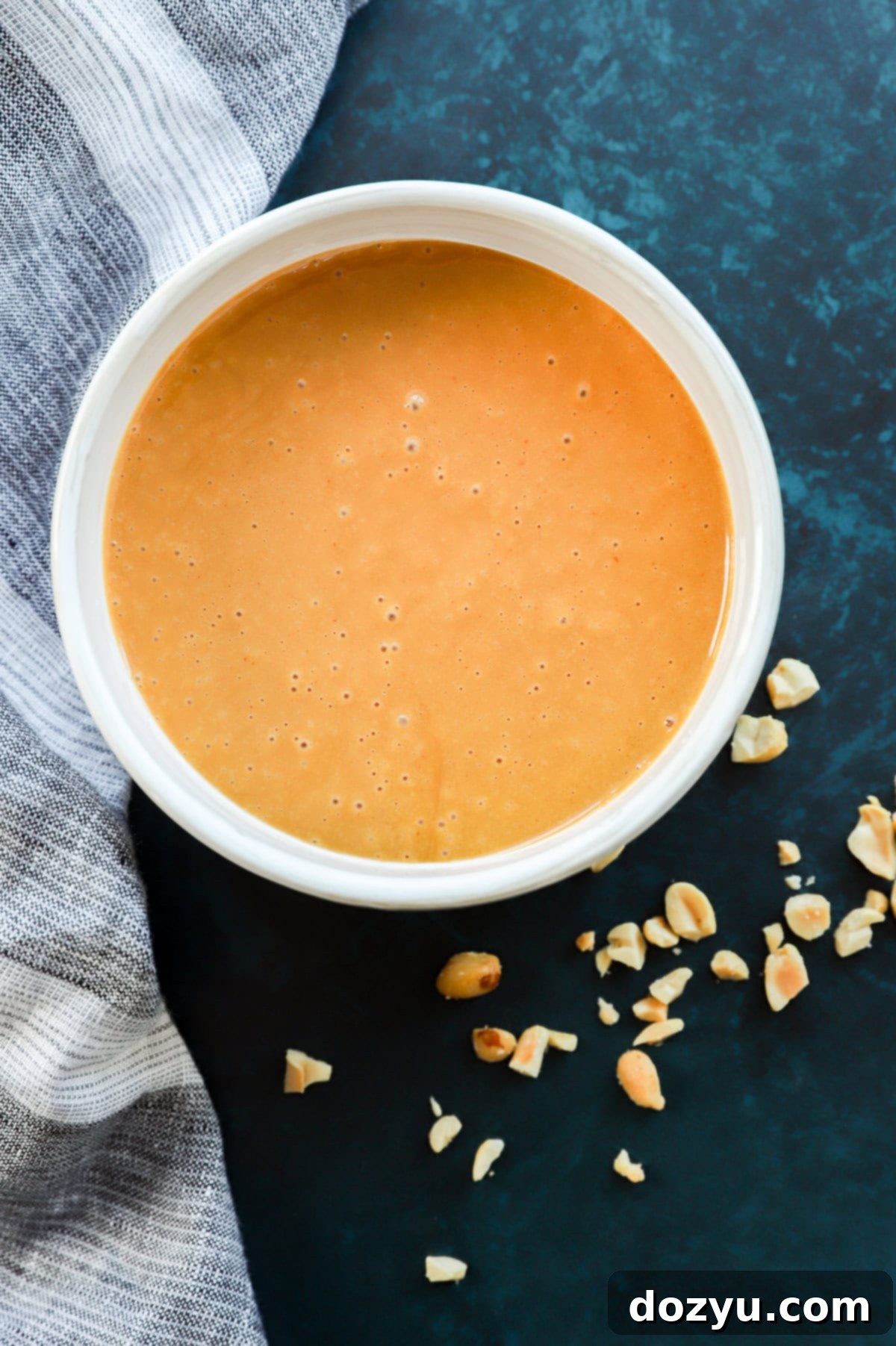
Homemade Thai Peanut Dressing Recipe Card
Equipment
-
Measuring Cups
-
Measuring Spoons
-
Vitamix Blender
Ingredients
- 1 Tbsp ginger paste or freshly grated ginger
- 2 cloves garlic minced
- 1/2 cup creamy peanut butter
- 1/3 cup fresh lime juice
- 1/3 cup low-sodium soy sauce (or Tamari for GF)
- 1/4 cup honey (or maple syrup/agave for vegan)
- 1/4 cup toasted sesame oil
- 1 Tbsp rice wine vinegar (or red wine vinegar)
- 2 tsp Sriracha (adjust to taste for spice)
- 1/4 tsp salt + more to taste
- Freshly cracked black pepper to taste
Instructions
-
Add the ginger paste (or grated ginger), minced garlic, peanut butter, fresh lime juice, soy sauce, honey (or chosen sweetener), toasted sesame oil, rice wine vinegar, Sriracha, and initial 1/4 tsp salt to a high-speed blender or food processor.
-
Blend until the mixture is completely smooth and creamy. If needed, pause and scrape down the sides of the blender to ensure all ingredients are fully incorporated.
-
Taste the dressing and adjust the seasoning as desired. Add more salt, freshly cracked black pepper, or Sriracha to enhance the flavors and heat to your preference. If it’s too thick, add water or more lime juice one tablespoon at a time until desired consistency.
-
Serve immediately over salads, as a dipping sauce, or as a flavorful marinade. Store any leftover dressing in an airtight container in the refrigerator for up to 4 days. Shake or stir well before each use.
